Carrie Chen's Digital Avatars Bridge Past and Future
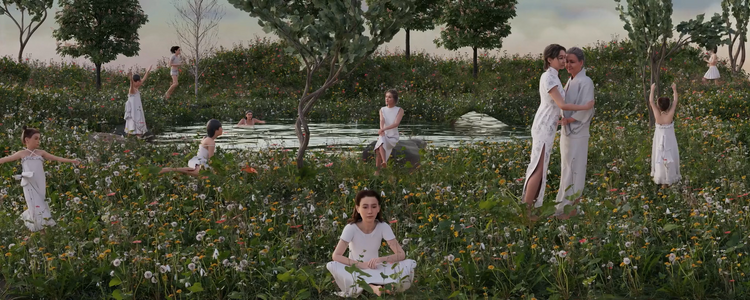
When Carrie Chen first projected 24 life-sized versions of herself onto a gallery wall for her fictional work, Temporal Portrait 时间肖像, she wasn't prepared for the physical reaction. There they were–all of these past and future versions of her, a dazzling blend of AI imagery, 3D character models, and archival images of her mother, grandmothers, and great-grandmothers. These versions of her were gathered together, some seated and some standing; some wizened with wisdom, and others were younger selves gazing into the distance. They blink and breathe at eye level.
"I didn't expect myself to have this physical or physiological reaction to it," she says. "It did feel ghostly in a sense, and I almost felt a real sense of presence."
We've all felt that moment, even looking at a mirror, where we wonder, Is that me? These days, when I look at myself, I can't help but see the face of my father. That micro-delay between the real and the imagined—the split second where Chen recognized these figures as both herself and not-herself, alive and synthetic—became the conceptual core of her practice. We know it in popular culture as the "uncanny valley," that productive discomfort when something appears almost but not quite human. "I know these aren't me; these aren't alive," she reflected. "But I'm seeing them move and blink and breathe at life-size scale."
But for Chen, the uncanny valley is not a problem to solve with new technology (regardless of what OpenAI or Midjourney might want you to believe) but a space to inhabit. Chen's work confronts fundamental questions about presence and identity in digital space—questions that have become urgent as AI-generated imagery floods our feeds and virtual representations multiply. Her self-portraits and moving tableaus exist in that productive discomfort of the uncanny valley: projections of her and other bodies that trigger contemplation despite their obvious artificiality.
From Christie's to Game Engines
Chen's path to digital art was anything but linear. She studied art history and psychology at NYU, worked at the Whitney and Christie's, and seemed destined for a career in arts administration. Her father, a painter who immigrated to New York from China in the 1980s, had spent her childhood warning her about the difficulties of artistic practice—especially for women. Her parents thought she would be a doctor because she loved anatomy books as a child. "I didn't want to be a doctor!" she protested. "I just like the human form. That should've been a sign I wanted to be an artist."
But working in traditional art institutions left her restless. Being in art, but not making it, is difficult. The turning point came from an unlikely source: her partner's interior design work. Watching him create 3D renderings of spaces looked, to Chen, "like playing The Sims, almost just dragging and dropping like chairs and different walls." She asked to try. "I sat down by his computer and I tried to click around and things started flashing," she laughs.
The real revelation came in 2015, when she wandered into a Samsung VR experience store in New York. The centerpiece was a Christmas-themed prototype: a sleigh you could sit on while wearing a VR headset. "It was sensational," she recalls, despite the milquetoast subject matter. This experience wasn't art in any conventional sense—just a commercial product in a showroom. But it opened her mind to something she'd never found in traditional galleries. "How light and color and sound and motion are all coalescing was not something I found in the traditional art spaces," she said.
These moments coalesced into a decision. She applied to UCLA's Design Media Arts program, drawn in part by Jennifer Steinkamp, whose work she'd first encountered in an undergraduate lecture. Steinkamp's large-scale digital flowers and trees, falling gently against black backgrounds, demonstrated how computational tools could achieve something painterly—abstraction through animation. "I saw a lot of parallels between or like sort of linking and making connections between her work and color field paintings," Chen says. When she discovered Steinkamp taught at UCLA, she put her application in the mail.

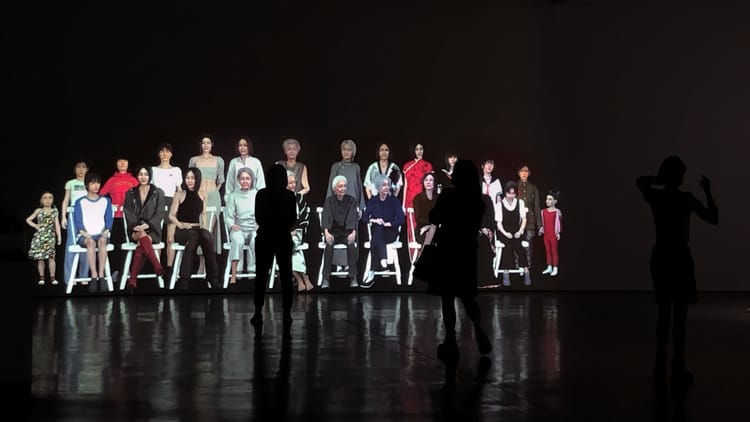

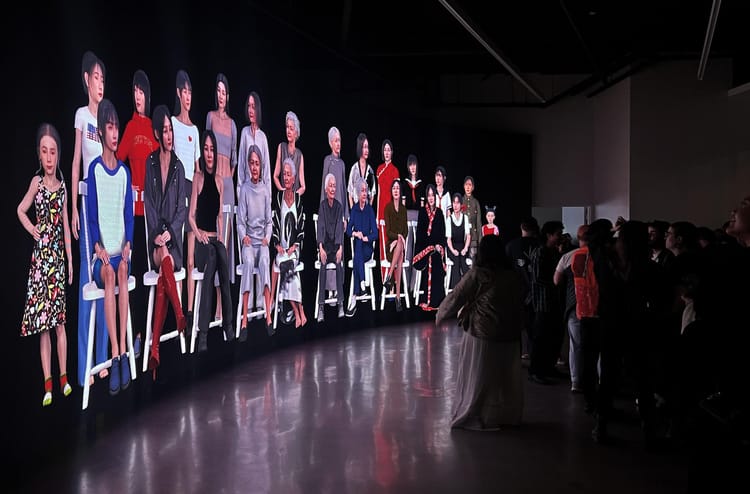
Temporal Portrait at Epoch Gallery, New Wight Gallery, and Vellum LA
Never Fully Here or There
In Spanish, there's a phrase I return to for children who move or are brought to the U.S. from their homeland: "Ni de aquí, ni de alla." Neither from here nor from there. That feeling of not really being anywhere runs through everything Chen makes, and it's an increasingly important question at a time when place and belonging are center stage. "Identity is something that I had to keep reassembling and constantly shifting and reforming," she says. "And that feeling of kind of never fully being here or there, that's actually a feeling that I'm really familiar with."
Born in the U.S., she moved to Shanghai with her family from first grade through middle school. "I had to learn about Chinese culture and what it means to be a Chinese American living in China," she explains. "So it was like having to deal with both sides of that identity." A relative once told her she didn't look distinctly like either parent. "And I think that stuck with me," Chen said. "And then I'm like, who am I?" I
When she visited her parents in Shanghai during grad school, her mother showed her a photograph Chen had never seen: her mom at three years old, sitting on her great-grandmother's lap. "I really haven't seen any documentation of my mother as a child," Chen says. "I just didn't have that visual in my head." The image was shot in a 1960s communist China photography style, with the two figures posed against a fake Tiananmen Square backdrop. "I saw a lot of similarities between that child and me. Photos of myself as if I were a three-year-old," she recalls. Suddenly, it all came together in a flood—past, present, and future; distance and proximity; separation and belonging.
That photograph became part of Temporal Portrait, the work where Chen first confronted her 24 projected selves. She used AI aging filters to generate images of herself at different life stages, then layered in ancestral photographs—her mother at three, her great-grandmother, and other family members. "I just wanted to take a more minimalist approach and really focus on these individual avatars," she said about adding a "synthetic generational quality to these base textures."
Unlike me, who has no video of themselves before the age of 24, Chen occupies a unique position, born before smartphones but young enough to witness their arrival. "I was really conscious of that development on the technological side, even though I was like a child," she says. She remembers Apple opening its first store in China when she was in elementary school, the excitement around each new iPod Touch, and the way social media platforms emerged and transformed how people stayed connected. This generational position—seeing both the before and after of ubiquitous digital memory—shapes how she thinks about time, identity, and the synthetic bridges AI now offers between past and future.
A Feel for Digital Bodies
But as she built her own "digital Carrie"—something shifted. "I really felt a connection and sense of empathy because it's more like a conversation with myself," she explains. She began thinking about where she would place this avatar and what it would be doing. The idea emerged of bringing together younger and older versions to create encounters across time. "Having done an art history major and working in museums, I just haven't really seen proper representation of someone like myself in a monumental sculptural way," she says.
A central theme in the work is the conversations we are constantly having with the digital versions of ourselves. "I thought it would be cool if I could meet younger versions of myself or older versions of myself and put them together in a sort of place," she explains. In many ways, that is who we are as embodied beings, an amalgamation of our past at the intersection where the future begins. And of course, there's the question of how accurate the depictions are. "We'll have to see," Chen laughs. "She'll be able to compare her actual face to the predicted versions, measure the gap between algorithmic imagination and biological fact. "I think she'll probably compare and kind of do a side-by-side," she muses.
But did creating these older versions change how she thinks about aging? Chen seems less interested in the predictions themselves than in what they enable—a conversation across time that wouldn't otherwise be possible. The images were "layers of documentation, like old photographs of my grandmother and even my great grandmother, and I kind of compiled them all with the AI image of me being middle-aged and then older," she explains. "So these were all like synthesized with ancestral photographs. So for me, I was like, maybe this will bring some additional element of realness or an interesting sort of synthetic generational quality to these base textures."
Spring and Its Discontents
Primavera, Chen's meditation on spring and renewal, again places multiple versions of her avatar self in an expansive digital landscape. The title references both Botticelli and the Italian word for spring, and the work draws on Renaissance and Romantic-period traditions of seasonal representation. "I always wanted to do a piece on seasons," she says. "It's such an archetype within art history, and I wanted to do my own take on it."
The Chinese landscape tradition meets Western art history in the composition. Avatars perform choreographed movements—dancing, twirling, walking—across a space filled with blossoming flowers. Some moments are staged for emotional resonance: a younger avatar embracing an older one, two child versions jogging and crisscrossing in the background. "I was really intrigued by the idea of expansive landscape with humans that are kind of spawned at different spots and performing these beautiful gestures and poses."
Chen used facial motion capture for the breathing and blinking—those "indicators of life" that trigger recognition of presence. The subtlety was a design choice. "I like to keep these like bodily animations more subtle because I knew that they would be eventually shown in a pretty big scale," she explained. The larger gestures were keyframed, predetermined animations that loop at compositionally chosen intervals.
Frustrated by the constraints of predetermined loops, Chen now wants rule-based systems rather than fixed choreography. "Like maybe this avatar only comes out when it's nighttime, or maybe during the morning time, these two avatars will jog past each other," she speculates. These "zero-player games"–built in-game engines but played as procedural animations–are a fitting development for Chen's avatar experimentations. They allowed the fixity of a consistent world and character with the spontaneity of liveness.
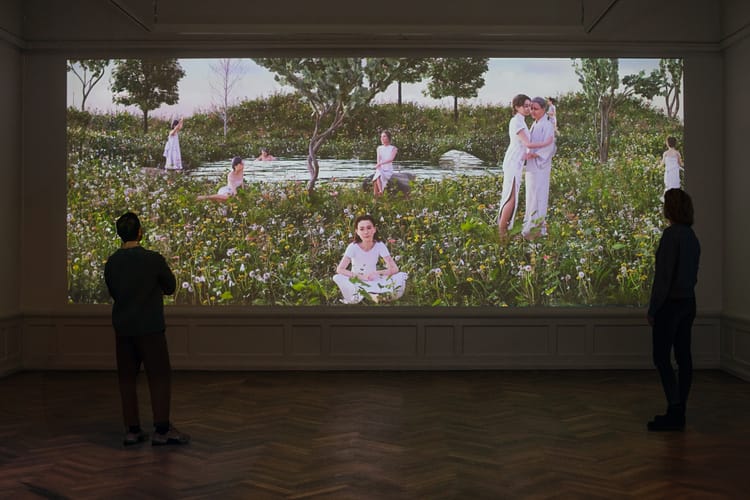
Chen pointed to The Sims as a touchpoint as well as Club Penguin and Neopets. These were worlds where you could construct alternate identities, spaces where "we can develop our own personalities and identities." In The Sims, she'd create versions of herself with varying levels of fidelity: one that resembled her actual interests (likes art, likes to paint), another with blue skin and completely different traits. "I loved it as a kid," she says. Looking at Primavera, I couldn't help but be reminded of The Sims' blend of intimacy, routine, and chaos as the game's characters try to fulfill their emotional desires. That game wasn't about perfect control—the characters had their own wants, their own routines, their own degree of agency within the system.
The question of scale matters to Chen. Her father works at a monumental scale—paintings and drawings that often fill entire walls. She's drawn to that same ambition because it's the appropriate way to communicate the feel of the humans in her work. "That sense of presence has almost a sculptural quality when they are depicted at a bigger life-size scale," she explains. Its presence without mass, form without substance, is another threshold condition that interests her.
What Comes Next
Looking ahead, Chen wants to push further into simulation and rule-based systems. She's teaching 3D at USC now—she's become the one explaining Rhino's complex interface to students—and continuing to develop her technical skills. "I think definitely in relation to game engines and simulations, that's something I'm working on right now, just learning more skills and how to program, how to create these systems," she says.
There's a long game here too, something Chen herself acknowledges with her hypothetical 90-year-old self. The comparison between AI prediction and biological aging isn't really the point. The work isn't about prediction accuracy—it's about the conversation between past and future selves, about what happens when you create digital versions of yourself and let them stare back.
"I do feel a sense of empathy towards these digital creations," she said, the repetition itself important. As if insisting on care and integrity toward synthetic beings—even ones that look like yourself—is a position that needs defending. In a marketplace filled with bodies designed for consumption, Chen builds avatars she treats like kin. They're not quite human, but they're not quite not human either. They exist in that productive in-between, that space of constant reassembly she's been navigating her whole life. Here or there. Present or absent. Real or synthetic. The answer, for Chen, is always both.

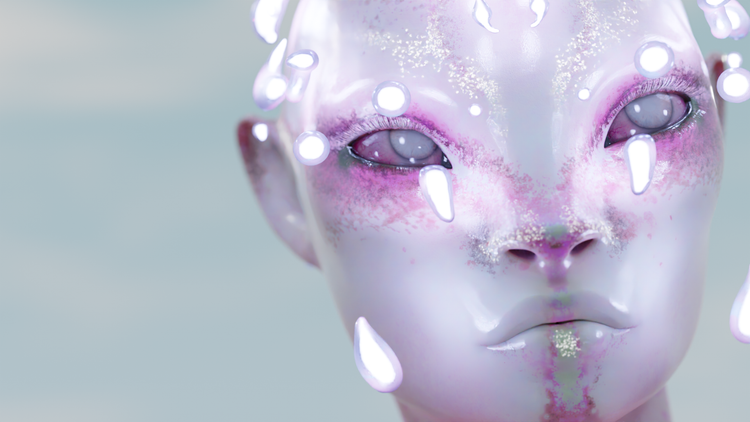

Comments ()